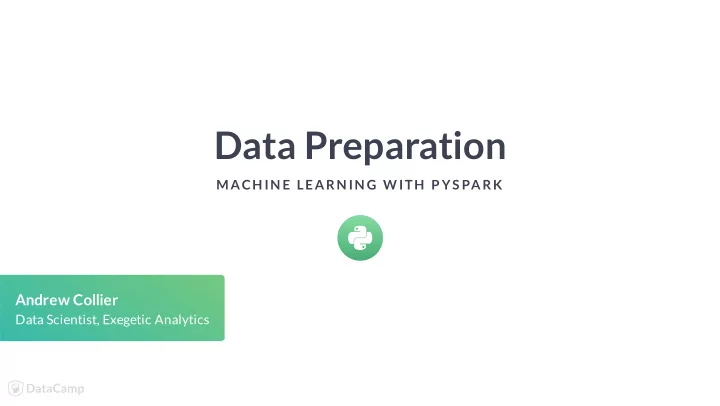

Data Preparation MACH IN E LEARN IN G W ITH P YS PARK Andrew Collier Data Scientist, Exegetic Analytics
Do you need all of those columns? +-----+-------+-------+------+----+----+------+------+----+-----------+ |maker| model| origin| type| cyl|size|weight|length| rpm|consumption| +-----+-------+-------+------+----+----+------+------+----+-----------+ |Mazda| RX-7|non-USA|Sporty|null| 1.3| 2895| 169.0|6500| 9.41| | Geo| Metro|non-USA| Small| 3| 1.0| 1695| 151.0|5700| 4.7| | Ford|Festiva| USA| Small| 4| 1.3| 1845| 141.0|5000| 7.13| +-----+-------+-------+------+----+----+------+------+----+-----------+ Remove the maker and model �elds. MACHINE LEARNING WITH PYSPARK
Dropping columns # Either drop the columns you don't want... cars = cars.drop('maker', 'model') # ... or select the columns you want to retain. cars = cars.select('origin', 'type', 'cyl', 'size', 'weight', 'length', 'rpm', 'consumption') +-------+------+----+----+------+------+----+-----------+ | origin| type| cyl|size|weight|length| rpm|consumption| +-------+------+----+----+------+------+----+-----------+ |non-USA|Sporty|null| 1.3| 2895| 169.0|6500| 9.41| |non-USA| Small| 3| 1.0| 1695| 151.0|5700| 4.7| | USA| Small| 4| 1.3| 1845| 141.0|5000| 7.13| +-------+------+----+----+------+------+----+-----------+ MACHINE LEARNING WITH PYSPARK
Filtering out missing data # How many missing values? cars.filter('cyl IS NULL').count() 1 Drop records with missing values in the cylinders column. cars = cars.filter('cyl IS NOT NULL') Drop records with missing values in any column. cars = cars.dropna() MACHINE LEARNING WITH PYSPARK
Mutating columns from pyspark.sql.functions import round # Create a new 'mass' column cars = cars.withColumn('mass', round(cars.weight / 2.205, 0)) # Convert length to metres cars = cars.withColumn('length', round(cars.length * 0.0254, 3)) +-------+-----+---+----+------+------+----+-----------+-----+ | origin| type|cyl|size|weight|length| rpm|consumption| mass| +-------+-----+---+----+------+------+----+-----------+-----+ |non-USA|Small| 3| 1.0| 1695| 3.835|5700| 4.7|769.0| | USA|Small| 4| 1.3| 1845| 3.581|5000| 7.13|837.0| |non-USA|Small| 3| 1.3| 1965| 4.089|6000| 5.47|891.0| +-------+-----+---+----+------+------+----+-----------+-----+ MACHINE LEARNING WITH PYSPARK
Indexing categorical data from pyspark.ml.feature import StringIndexer +-------+--------+ | type|type_idx| indexer = StringIndexer(inputCol='type', +-------+--------+ outputCol='type_idx') |Midsize| 0.0| <- most frequent value | Small| 1.0| |Compact| 2.0| # Assign index values to strings | Sporty| 3.0| indexer = indexer.fit(cars) | Large| 4.0| | Van| 5.0| <- least frequent value # Create column with index values +-------+--------+ cars = indexer.transform(cars) Use stringOrderType to change order. MACHINE LEARNING WITH PYSPARK
Indexing country of origin # Index country of origin: +-------+-----+ # | origin|label| # USA -> 0 +-------+-----+ # non-USA -> 1 | USA| 0.0| # |non-USA| 1.0| cars = StringIndexer( +-------+-----+ inputCol="origin", outputCol="label" ).fit(cars).transform(cars) MACHINE LEARNING WITH PYSPARK
Assembling columns Use a vector assembler to transform the data. from pyspark.ml.feature import VectorAssembler assembler = VectorAssembler(inputCols=['cyl', 'size'], outputCol='features') assembler.transform(cars) +---+----+---------+ |cyl|size| features| +---+----+---------+ | 3| 1.0|[3.0,1.0]| | 4| 1.3|[4.0,1.3]| | 3| 1.3|[3.0,1.3]| +---+----+---------+ MACHINE LEARNING WITH PYSPARK
Let's practice! MACH IN E LEARN IN G W ITH P YS PARK
Decision Tree MACH IN E LEARN IN G W ITH P YS PARK Andrew Collier Data Scientist, Exegetic Analytics
Anatomy of a Decision Tree: Root node MACHINE LEARNING WITH PYSPARK
Anatomy of a Decision Tree: First split MACHINE LEARNING WITH PYSPARK
Anatomy of a Decision Tree: Second split MACHINE LEARNING WITH PYSPARK
Anatomy of a Decision Tree: Third split MACHINE LEARNING WITH PYSPARK
Classifying cars Classify cars according to country of manufacture. +---+----+------+------+----+-----------+----------------------------------+-----+ |cyl|size|mass |length|rpm |consumption|features |label| +---+----+------+------+----+-----------+----------------------------------+-----+ |6 |3.0 |1451.0|4.775 |5200|9.05 |[6.0,3.0,1451.0,4.775,5200.0,9.05]|1.0 | |4 |2.2 |1129.0|4.623 |5200|6.53 |[4.0,2.2,1129.0,4.623,5200.0,6.53]|0.0 | |4 |2.2 |1399.0|4.547 |5600|7.84 |[4.0,2.2,1399.0,4.547,5600.0,7.84]|1.0 | |4 |1.8 |1147.0|4.343 |6500|7.84 |[4.0,1.8,1147.0,4.343,6500.0,7.84]|0.0 | |4 |1.6 |1111.0|4.216 |5750|9.05 |[4.0,1.6,1111.0,4.216,5750.0,9.05]|0.0 | +---+----+------+------+----+-----------+----------------------------------+-----+ label = 0 -> manufactured in the USA = 1 -> manufactured elsewhere MACHINE LEARNING WITH PYSPARK
Split train/test Split data into training and testing sets. # Specify a seed for reproducibility cars_train, cars_test = cars.randomSplit([0.8, 0.2], seed=23) Two DataFrames: cars_train and cars_test . [cars_train.count(), cars_test.count()] [79, 13] MACHINE LEARNING WITH PYSPARK
Build a Decision Tree model from pyspark.ml.classification import DecisionTreeClassifier Create a Decision Tree classi�er. tree = DecisionTreeClassifier() Learn from the training data. tree_model = tree.fit(cars_train) MACHINE LEARNING WITH PYSPARK
Evaluating Make predictions on the testing data and compare to known values. prediction = tree_model.transform(cars_test) +-----+----------+---------------------------------------+ |label|prediction|probability | +-----+----------+---------------------------------------+ |1.0 |0.0 |[0.9615384615384616,0.0384615384615385]| |1.0 |1.0 |[0.2222222222222222,0.7777777777777778]| |1.0 |1.0 |[0.2222222222222222,0.7777777777777778]| |0.0 |0.0 |[0.9615384615384616,0.0384615384615385]| |1.0 |1.0 |[0.2222222222222222,0.7777777777777778]| +-----+----------+---------------------------------------+ MACHINE LEARNING WITH PYSPARK
Confusion matrix A confusion matrix is a table which describes performance of a model on testing data. prediction.groupBy("label", "prediction").count().show() +-----+----------+-----+ |label|prediction|count| +-----+----------+-----+ | 1.0| 1.0| 8| <- True positive (TP) | 0.0| 1.0| 2| <- False positive (FP) | 1.0| 0.0| 3| <- False negative (FN) | 0.0| 0.0| 6| <- True negative (TN) +-----+----------+-----+ Accuracy = (TN + TP) / (TN + TP + FN + FP) — proportion of correct predictions. MACHINE LEARNING WITH PYSPARK
Let's build Decision Trees! MACH IN E LEARN IN G W ITH P YS PARK
Logistic Regression MACH IN E LEARN IN G W ITH P YS PARK Andrew Collier Data Scientist, Exegetic Analytics
Logistic Curve MACHINE LEARNING WITH PYSPARK
Logistic Curve MACHINE LEARNING WITH PYSPARK
Logistic Curve MACHINE LEARNING WITH PYSPARK
Logistic Curve MACHINE LEARNING WITH PYSPARK
Logistic Curve MACHINE LEARNING WITH PYSPARK
Logistic Curve MACHINE LEARNING WITH PYSPARK
Logistic Curve MACHINE LEARNING WITH PYSPARK
Cars revisited Prepare for modeling: assemble the predictors into a single column (called features ) and split data into training and testing sets. +---+----+------+------+----+-----------+----------------------------------+-----+ |cyl|size|mass |length|rpm |consumption|features |label| +---+----+------+------+----+-----------+----------------------------------+-----+ |6 |3.0 |1451.0|4.775 |5200|9.05 |[6.0,3.0,1451.0,4.775,5200.0,9.05]|1.0 | |4 |2.2 |1129.0|4.623 |5200|6.53 |[4.0,2.2,1129.0,4.623,5200.0,6.53]|0.0 | |4 |2.2 |1399.0|4.547 |5600|7.84 |[4.0,2.2,1399.0,4.547,5600.0,7.84]|1.0 | |4 |1.8 |1147.0|4.343 |6500|7.84 |[4.0,1.8,1147.0,4.343,6500.0,7.84]|0.0 | |4 |1.6 |1111.0|4.216 |5750|9.05 |[4.0,1.6,1111.0,4.216,5750.0,9.05]|0.0 | +---+----+------+------+----+-----------+----------------------------------+-----+ MACHINE LEARNING WITH PYSPARK
Build a Logistic Regression model from pyspark.ml.classification import LogisticRegression Create a Logistic Regression classi�er. logistic = LogisticRegression() Learn from the training data. logistic = logistic.fit(cars_train) MACHINE LEARNING WITH PYSPARK
Predictions prediction = logistic.transform(cars_test) +-----+----------+---------------------------------------+ |label|prediction|probability | +-----+----------+---------------------------------------+ |0.0 |0.0 |[0.8683802216422138,0.1316197783577862]| |0.0 |1.0 |[0.1343792056399585,0.8656207943600416]| |0.0 |0.0 |[0.9773546766387631,0.0226453233612368]| |1.0 |1.0 |[0.0170508265586195,0.9829491734413806]| |1.0 |0.0 |[0.6122241729292978,0.3877758270707023]| +-----+----------+---------------------------------------+ MACHINE LEARNING WITH PYSPARK
Recommend
More recommend